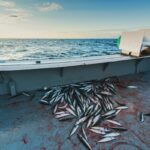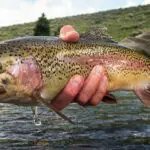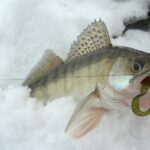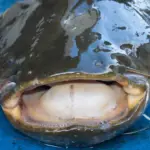Redfish, also called red drum, is one of the most popular game fish found in waters ranging from Massachusetts to the Gulf of Mexico. And, while you may enjoy catching and releasing the Redfish, you may also want to know if you can eat it.
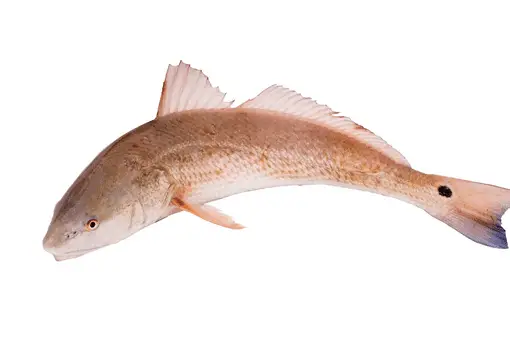
The short answer? You can eat Redfish! Read on for more information on cooking and preparing Redfish, the best areas to catch red drum, and how it differs from other beloved pescatarian options.
What Is Redfish?
Sciaenops ocellatus, or Redfish, are relatively large fish in nearly all of the Atlantic and the Gulf of Mexico. They have silvery, shiny scales along the body and reddish and copper-toned scales around the fins and face – although the red colors may be diffused or less apparent on some fish. Redfish also have a black dot on their back fin.
Red drums can weigh up to 55 pounds and usually grow to 100 cm. The longest Redfish on record was 155 centimeters. These resilient game fish can live up to 50 years and are the only species in the Sciaenops genus.
The Redfish is the state saltwater fish of North Carolina and feeds in brackish, shallow, and sandy water on mollusks and other crustaceans.
Where Do You Find Redfish?
As mentioned above, Redfish dwell in the Atlantic from Massachusetts to Florida, including the Gulf of Mexico and southern Florida.
Red drums love shallow waters (1-4 feet) with plenty of grass and seaweed to hide in – and for feeding. They typically gather around piers and docks but flock to oyster bars and surf bays. Their strong teeth let them split open hard shells and other shellfish.
Redfish are adaptable and can survive in salt and freshwater. It’s not unheard of to find them in rivers and streams!
Redfish are a schooling species and can reach into the thousands per group. They tend to fight when hooked on a line but aren’t dangerous to humans. During mating season, the male fish create vibrating sounds in their underbelly – hence the nickname red drum.
What Do Redfish Taste Like?
Most people say Redfish has a mild, not super-fishy taste, with a subtly sweet flavor. The texture is relatively firm and not as flaky as a cod or haddock filet. Redfish fall apart into large chunks, so many people put it in stews or soups.
The primary factor to keep in mind when making Redfish is size. Like most fish, texture and taste diminish with large catches. Redfish taste best at about 10 to 15 pounds. They become tough and gamey at the 20-pound mark.
Comparable species (at least in flavor) to the Redfish are black sea bass, grouper, monkfish, and haddock.
Can You Eat Redfish Raw?
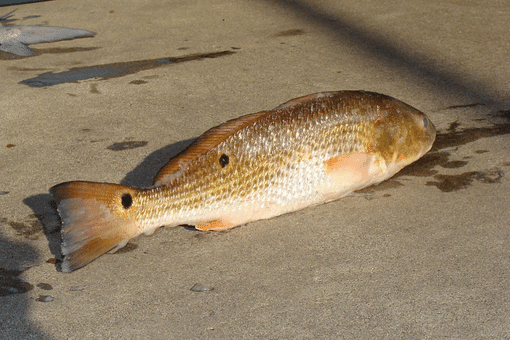
Like most other saltwater fish, you should not eat Redfish without cooking it thoroughly. Many Redfish carry parasites and bacteria that will not die until they reach a specific temperature.
Never consume Redfish in sushi or sashimi, and always check the temperature of the fish before you eat it – food poisoning can be potentially life-threatening, and consuming worms isn’t at the top of anyone’s to-do list.
What Is the Difference Between Redfish and Red Snapper?
While they each have red in their name and live in the same areas, there are almost no similarities between Red Snapper and Redfish beyond those characteristics. Below are some additional differences between the two fish.
Color
The Redfish is a coppery, muted red that shifts to silver in the light. Its fins are similar in coloring, and it has a black dot (sometimes multiple) on its hind fin.
Red Snappers are bright, flame-red, and much more vibrant than Redfish. Their entire bodies are red, while the Redfish has splotches of faded red throughout.
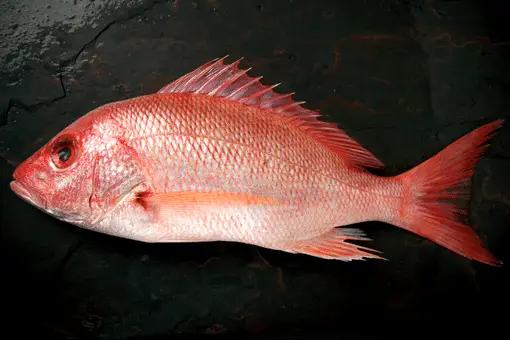
Body Shape
Redfish are long, slender, and large. Their heads extend out quite a bit, and their fins run along their spines, with two dorsal fins in varying sizes. The Redfish jaw has an underbite, making it easy to scoop up crustaceans and other hard-shelled creatures.
Red Snappers are short, squat, and usually do not exceed 20 pounds. They have a single dorsal fin and an oval-shaped frame. Their back has more of an arch than the Redfish, and they have an overbite.
Preferred Habitat
As mentioned earlier, Redfish love shallow, muddy waters with plenty of vegetation. They are easy to catch via shore fishing and even in creeks – although the younger varieties tend to stay in the less expansive habitats.
Red Snappers, however, prefer deep water and are bottom feeders. They can be found up to 600 feet deep, while Redfish rarely exceed a depth of 100 feet. Snappers enjoy hanging around wrecks and reefs and eat shrimp, crabs, worms, and other bottom-dwelling creatures.
How To Prepare Redfish for Cooking
Before you make a delicious meal with Redfish as the primary ingredient, ensure you know how to prepare it after a catch.
If you want to cook your Redfish right after you catch it, you need to bleed it out immediately after you take the hook out of its mouth. After that process is complete, take a knife and cut along the dorsal fin. Separate the fish into two halves and remove the internal organs (and Spaghetti worms, potentially). Keep it cold in the fridge or frozen if you plan on eating it later.
You may also want to remove the skin from the Redfish before eating it. Remove the skin from the top of the fish, but leave the bottom layer for a crispy texture. The bottom skin helps signal when the fish finishes cooking.
How To Cook Redfish
Redfish are relatively versatile, and its recipes range from super-simple and fresh to fine dining. Below are a few ideas and steps for cooking Redfish.
Sauteed Redfish
By far the quickest and easiest method, sauteing Redfish in a pan is a delicious feast with plenty of seasoning and side options.
If you plan to cook your Redfish in the filet style, apply your seasonings first. Thyme, basil, oregano, or spicy favorites like Old Bay are all excellent on Redfish. Rub olive oil on the fish before you add seasonings, so they stick, then place the fish in a pan with butter or a non-stick cooking spray.
Watch the skin on the bottom of the fish – if it becomes crispy and you can smoothly move it with a spatula, it’s done cooking. For extra zest, top the fish with lemon and serve with rice, veggies, or another side of your choice.
On the Grill
Grilled Redfish is a perfect summer meal, simple to make, and great for outdoor gatherings.
Create slits in the skin of the filets before you place the fish on the grill for even cooking. Rinse the Redfish in cool water and pat it dry.
Brush the skin (if any) with olive oil, ensuring you cover all of the scales. Use whatever seasonings you want on the fleshy side. Coat the grate of the grill in olive oil, so the fish does not stick during cooking.
Set the grill to medium-high. Place the Redfish on the grill skin side down, and let it cook for 5 minutes. Flip it gently but quickly to avoid flaking, and grill for another 3 minutes. Voila – your Redfish is ready!
Roasted or Baked
Healthy, fast, and yummy, roasting your Redfish in the oven is an excellent way to keep the flavor of the fish in the skin and enjoy its mild sweetness.
Place a piece of parchment paper on a baking sheet. If you have multiple files, try to place them as close to the middle as possible. Add fresh veggies, balsamic, parmesan, and additional herbs if desired.
Put it in the oven for 8-10 minutes at 400 degrees Fahrenheit, check for flakiness, and serve.
- Do You Need An Indicator For Nymph Fishing? - November 16, 2023
- Fishing Safety Tips For Families - September 25, 2023
- What Is The Best Time To Night Fish At A Lake? - September 18, 2023



